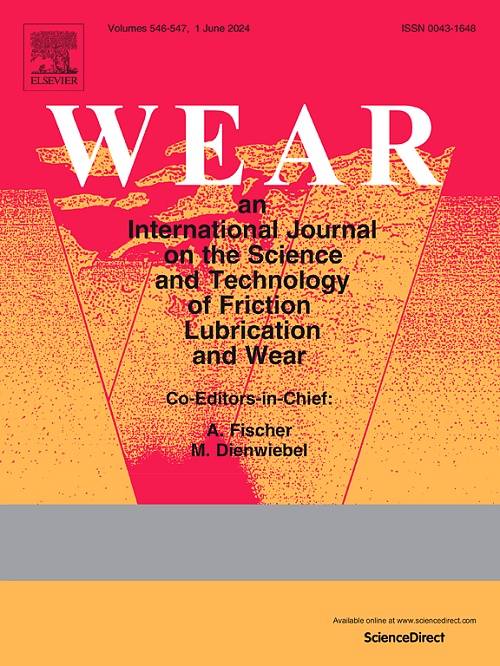Damage assessment of 6H-SiC under repeated nano-scratching
IF 6.1
1区 工程技术
Q1 ENGINEERING, MECHANICAL
引用次数: 0
Abstract
Monocrystalline silicon carbide (SiC) is a promising next-generation semiconductor material, and ultra-precision machining techniques such as grinding, polishing, and lapping are essential in the fabrication of SiC-based devices. During these processes, randomly dispersed abrasive grains interact with the SiC wafer through contact sliding, removing material via repeated nano-scale scratching. This study investigates the underlying mechanisms of material removal, aiming at minimal subsurface damage, through detailed nano-scale experimental analyses using atomic force microscopy (AFM). Experiments were performed on 6H-SiC surfaces under a constant AFM tip load of 8 μN. The surface and subsurface microstructural evolution were analyzed using scanning electron microscopy (SEM) and high-resolution transmission electron microscopy (HRTEM). Results show that as the number of nano-scratching cycles increases under consistent loading conditions, the thickness of the amorphous layer stabilizes without further phase transformations or defect formation. A uniform amorphous layer, 3–5 nm thick, develops in the top subsurface, with no lattice defects present beneath it. Due to tip wear and changes in the ratio of undeformed chip thickness to tip radius, the material removal mechanism shifts from extrusion-shearing dominated cutting to plowing. The complex stress field and stress gradient, combined with the material's anisotropic microstructure, introduces multifaceted plastic deformation in the top subsurface during plowing, resulting in irregular amorphization and lateral lattice distortions. This leads to material pile-ups containing both crystalline and amorphous phases along the nanogroove.
6H-SiC重复纳米划伤损伤评估
单晶硅碳化硅(SiC)是一种很有前途的下一代半导体材料,在制造基于SiC的器件中,超精密加工技术如研磨、抛光和研磨是必不可少的。在这些过程中,随机分散的磨料颗粒通过接触滑动与SiC晶圆相互作用,通过重复的纳米级划痕去除材料。本研究通过使用原子力显微镜(AFM)进行详细的纳米级实验分析,探讨了材料去除的潜在机制,旨在实现最小的亚表面损伤。在恒定的8 μN原子力显微镜针尖载荷下,对6H-SiC表面进行了实验。利用扫描电镜(SEM)和高分辨率透射电镜(HRTEM)分析了表面和地下微观结构的演变。结果表明:在恒定载荷条件下,随着纳米划痕循环次数的增加,非晶层的厚度趋于稳定,不再发生相变或形成缺陷;顶部亚表面形成3-5 nm厚的均匀非晶态层,其下无晶格缺陷。由于刀尖磨损和未变形切屑厚度与刀尖半径之比的变化,材料去除机制由挤压剪切为主的切削转变为犁削为主。复杂的应力场和应力梯度,加上材料的各向异性微观结构,在犁耕过程中,在顶部次表面引入了多方面的塑性变形,导致不规则的非晶化和侧向晶格畸变。这导致沿纳米沟槽堆积的材料中既有晶态又有非晶态。
本文章由计算机程序翻译,如有差异,请以英文原文为准。
求助全文
约1分钟内获得全文
求助全文
来源期刊

Wear
工程技术-材料科学:综合
CiteScore
8.80
自引率
8.00%
发文量
280
审稿时长
47 days
期刊介绍:
Wear journal is dedicated to the advancement of basic and applied knowledge concerning the nature of wear of materials. Broadly, topics of interest range from development of fundamental understanding of the mechanisms of wear to innovative solutions to practical engineering problems. Authors of experimental studies are expected to comment on the repeatability of the data, and whenever possible, conduct multiple measurements under similar testing conditions. Further, Wear embraces the highest standards of professional ethics, and the detection of matching content, either in written or graphical form, from other publications by the current authors or by others, may result in rejection.
 求助内容:
求助内容: 应助结果提醒方式:
应助结果提醒方式:


